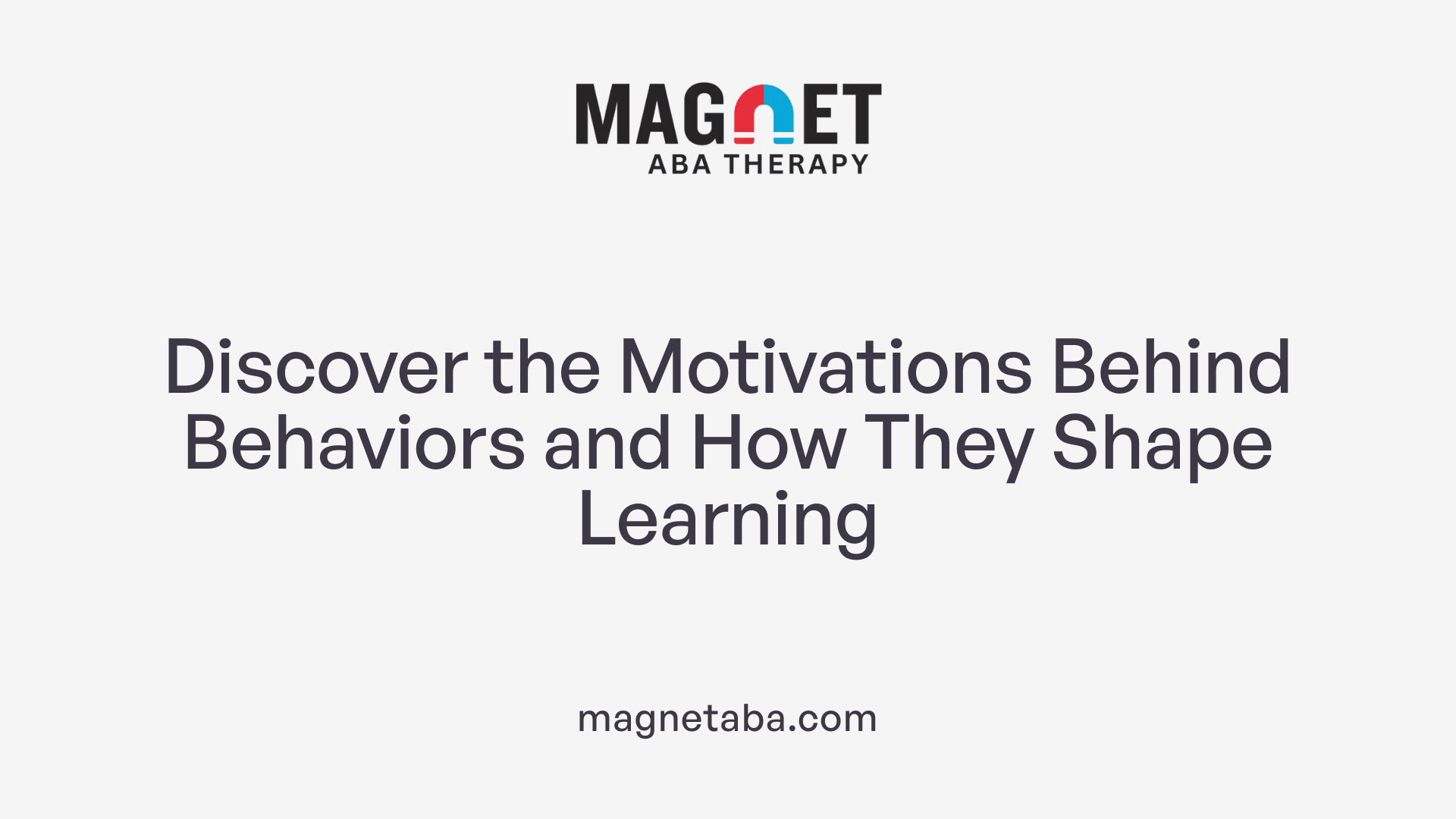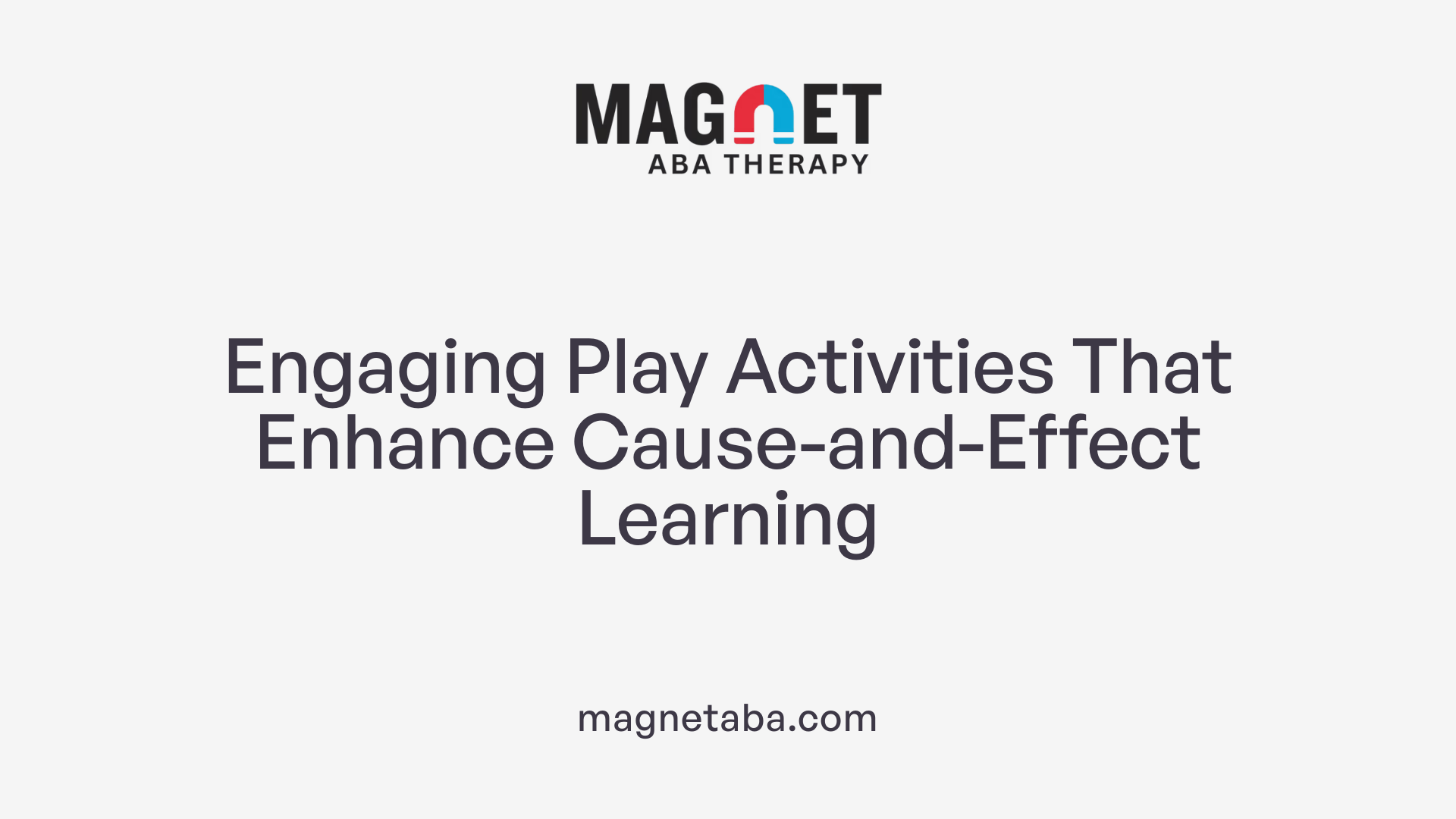Introduction to ABA and Its Role in Cause-and-Effect Education
Applied Behavior Analysis (ABA) is a scientifically validated approach that plays a vital role in teaching children with autism and other developmental challenges about cause-and-effect relationships. Rooted in behavioral science, ABA uses systematic techniques to foster skills that are essential for daily functioning, communication, and social interaction. This article explores how ABA teaches cause and effect, the methods involved, supporting evidence, and resources available for caregivers.
The Foundations of ABA and Cause-and-Effect Teaching
How does ABA therapy teach cause and effect?
ABA therapy fosters an understanding of cause-and-effect relationships primarily through structured, hands-on activities and behavioral techniques. For example, children might play with toys that produce lights or sounds when pressed, which helps them see the direct link between their actions and the resulting outcomes. Techniques such as Discrete Trial Training (DTT) and Natural Environment Teaching (NET) are fundamental, systematically presenting stimuli and reinforcing responses to highlight this connection.
Therapists analyze how children respond to different stimuli using the ABC (antecedent-behavior-consequence) model, which identifies what triggers behaviors and what reinforces them. For example, a child asking for a toy and receiving it demonstrates the cause-and-effect in communication. Data collection tools like precision teaching charts help illustrate to children how their behaviors lead to specific environmental reactions, reinforcing causal understanding.
Prompting and task analysis break down complex actions into simple steps, making cause-and-effect more accessible. Over time, children learn how their behaviors influence their surroundings, fostering more independence and purposeful actions. Overall, ABA systematically emphasizes clear, repeatable cause-and-effect patterns to build skills crucial for daily functioning.
Behavioral Techniques That Reinforce Cause-and-Effect Learning

What techniques and methods are used in ABA to teach cause and effect?
Applied Behavior Analysis (ABA) employs various structured techniques to help children understand cause-and-effect relationships. Discrete Trial Training (DTT) systematically presents stimuli and prompts, rewarding correct responses to reinforce learning of connections between actions and outcomes.
Natural Environment Teaching (NET) integrates learning into everyday activities, making cause-and-effect concepts more meaningful and generalizable. Modeling behavior is also fundamental, where therapists demonstrate desired responses for children to imitate, providing a clear example of action leading to a consequence.
The ABC model—Antecedent, Behavior, and Consequence—is another useful tool. It helps analyze the environmental triggers that influence behavior and the subsequent reactions, allowing therapists to reinforce positive behaviors effectively.
Functional Behavioral Assessment (FBA) identifies why challenging behaviors occur, focusing on their purpose, such as gaining access to something or escaping from an unpleasant situation. Based on this understanding, targeted approaches like Functional Communication Training (FCT) teach children alternative ways to communicate.
Prompting strategies, including visual cues or verbal hints, assist children in performing new skills by guiding their actions. Task analysis breaks complex behaviors into manageable steps, facilitating easier learning and understanding of cause-and-effect.
Together, these evidence-based methods provide repeated opportunities for practice and reinforcement, shaping a child's understanding of how their actions influence outcomes in both controlled and natural settings.
Understanding Behavioral Functions and Their Impact on Cause-and-Effect Learning

What are the functions of behaviors linked to cause-and-effect?
In Applied Behavior Analysis (ABA), understanding why a behavior happens—its function—is central to teaching children with autism about cause and effect. The primary purposes of behaviors are to access rewards or to escape from unpleasant situations.
For example, a child might throw a tantrum to get a toy or attract attention, which is an effort to obtain a reward or positive reinforcement. Conversely, a child might avoid eating certain foods or doing chores by acting out, aiming to escape an unpleasant task.
Recognizing these functions helps therapists design interventions that teach children appropriate ways to communicate and cope. When children realize that polite requests or social cues can lead to positive outcomes, they grasp cause-and-effect relationships. Likewise, learning that asking for a break or help can prevent or escape discomfort shows how their actions influence the environment.
This understanding is fundamental for fostering the development of social skills and self-regulation, laying the groundwork for more complex cause-and-effect learning.
How does understanding behavior functions assist in teaching cause-and-effect?
Knowledge of behavior functions is essential for creating effective ABA interventions. It allows therapists to tailor strategies that help children see how their actions lead to specific outcomes.
For behaviors aimed at getting rewards, children are taught alternative, appropriate behaviors—such as requesting politely—to achieve their goals. This direct teaching emphasizes how certain actions produce positive results, reinforcing cause-and-effect comprehension.
In cases where behaviors serve to escape or avoid situations, therapists work on teaching coping skills or alternative communication methods. These new skills help children understand that their responses can influence their environment, providing a sense of control and reducing reliance on maladaptive behaviors.
Through this process, children learn that their actions have tangible consequences, which supports their overall learning about cause and effect in social and daily life settings.
In what ways do functional assessments inform ABA interventions?
Functional assessments are systematic observations and analyses that identify the purpose behind challenging behaviors.
By determining whether a behavior is motivated by access to reinforcement or the need to escape something uncomfortable, therapists can develop targeted intervention plans. For example, if a child's tantrums are driven by a desire to avoid chores, the intervention might involve teaching the child to request breaks appropriately.
These assessments enable the creation of personalized strategies that directly address the real reasons behind behaviors. They facilitate teaching alternative responses that fulfill the same function, thereby reducing problem behaviors and promoting positive, cause-and-effect understanding.
Ultimately, functional assessments serve as a foundation for effective ABA therapy, guiding interventions that foster awareness of how actions lead to specific results, enhancing learning, independence, and social success.
| Aspect | Description | Example |
|---|---|---|
| Behavior’s function | Why the behavior occurs | Seeking toys or avoiding chores |
| Intervention focus | Teaching appropriate responses based on function | Requesting politely or taking a break |
| Role of assessment | Identifies function to tailor strategies | Observation of crying to escape tasks |
| Outcomes | Improved understanding of cause-and-effect; reduced maladaptive behaviors | Using communication to achieve desired results |
| Techniques used | Reinforcement, prompting, modeling | Giving praise for appropriate requests |
Understanding the relationship between behavior functions and cause-and-effect learning is vital in ABA. It enriches the approach by ensuring interventions are meaningful, effective, and personalized to each individual’s needs.
Integrating Routines and Daily Activities to Reinforce Cause-and-Effect

How does ABA teach cause-and-effect through routines?
Applied Behavior Analysis (ABA) employs predictable routines and daily activities to teach children the fundamental concept of cause-and-effect. By structuring daily tasks in a consistent manner, children learn the link between their actions and the outcomes that follow. For instance, when a child follows a handwashing routine—turning on the tap, applying soap, rinsing, and drying—they observe clear results from each behavior.
Reinforcing correct execution of these routines through praise or rewards helps children understand that their specific behaviors lead to positive and functional results. The use of visual schedules or prompts further enhances this understanding by providing concrete cues that link actions to consequences. Over time, children begin to anticipate outcomes based on their behaviors, fostering independence and the ability to respond appropriately to environmental cues, which are essential skills in cause-and-effect learning.
Through consistent practice and reinforcement, routines serve as practical tools in ABA to develop a child's awareness of how their actions influence their environment and daily life.
What role do visual supports play in teaching cause-and-effect concepts?
Visual supports are vital in making cause-and-effect relationships accessible, especially for children with autism who often benefit from concrete visual cues. These supports include schedules, picture cues, charts, and step-by-step guides, which visually depict routines and expected behaviors.
Using visual aids helps children comprehend the sequence of actions and their outcomes. For example, a picture chart showing steps for cleaning up a room or preparing a snack clearly illustrates how specific behaviors lead to desired results. This concrete representation helps children grasp the idea that their actions have direct consequences.
Visual supports promote independence by enabling children to recall and follow routines without constant verbal prompts. They also make abstract cause-and-effect concepts tangible, which encourages children to apply learned relationships across various settings. Overall, visuals serve as powerful tools that reinforce understanding, facilitate learning, and support the development of self-management skills in everyday life.
The Impact of Play and Engagement in Cause-and-Effect Learning

How Do Role-Playing, Matching Games, Sensory Bins, and Puzzles Contribute to Cause-and-Effect Understanding?
Play-based strategies are fundamental in teaching children about cause-and-effect relationships, especially within Applied Behavior Analysis (ABA) therapy. Through engaging activities like role-playing, children actively explore how their actions result in specific outcomes.
Role-playing and pretend play are powerful tools for social and emotional development. When children act out daily scenarios, they learn about social cues, decision-making, and the consequences of their actions in a natural context. For example, simulating a grocery store experience helps children understand buying items leads to receiving goods.
Matching games enhance visual scanning, focus, and memory, helping children recognize patterns and relationships. When kids match similar objects or pictures, they grasp the idea that certain actions or choices lead to specific results, fostering understanding of cause-and-effect.
Sensory bins expose children to various textures and sensations, promoting sensory processing skills. Exploring different materials and textures teaches children that certain actions—like squeezing or touching—lead to different sensory responses, laying a foundation for understanding cause and effect in sensory-rich environments.
Puzzle-solving activities improve fine motor skills, hand-eye coordination, vocabulary, and problem-solving. As children complete puzzles, they see how manipulating pieces leads to a finished picture, reinforcing the concept that their actions have direct outcomes.
How Do Singing and Story Reading Foster Cause-and-Effect Skills?
Singing songs with patterned melodies and repetitive lyrics help develop vocal and echoic skills. These activities also provide natural opportunities for children to notice patterns and predict what comes next, illustrating cause-and-effect relationships within musical and linguistic frameworks.
Reading stories offers a rich context to understand cause-and-effect through characters’ decisions and their consequences. When a character makes a choice, and a change occurs as a result, children learn about the link between actions and outcomes. Additionally, stories help foster joint attention—a crucial social skill for understanding cause-and-effect in social interactions.
How Does Play Support the Development of Cause-and-Effect Understanding in ABA?
These play activities are more than just fun; they are strategic interventions that help children grasp complex concepts. For example, through playing with sensory bins or completing puzzles, children observe that their actions cause specific responses.
Moreover, simultaneous reinforcement techniques, such as praise or tangible rewards, can be incorporated into play to strengthen cause-and-effect learning. As children experience positive outcomes from their actions, they are motivated to repeat those behaviors, deepening their understanding.
Practical Applications of Play-Based Strategies in ABA
ABA therapists frequently integrate play into learning routines to teach cause-and-effect skills effectively. For example, therapists might use role play to teach social cues or set up matching games to teach pattern recognition.
These activities help teach essential skills like requesting items (using words or gestures), following routines, and understanding social boundaries—all of which are grounded in cause-and-effect relationships.
| Activity Type | Learning Focus | How It Reinforces Cause-and-Effect |
|---|---|---|
| Role-playing | Social skills, daily routines | Actions lead to realistic outcomes |
| Matching games | Pattern recognition, focus | Choices produce matching results |
| Sensory bins | Sensory processing | Actions evoke sensory responses |
| Puzzles | Fine motor coordination, problem-solving | Piece placement leads to complete images |
| Singing songs | Language, pattern recognition | Repeated patterns demonstrate cause-and-effect |
| Story reading | Social understanding, emotional skills | Characters’ actions lead to effects |
Understanding cause and effect is crucial for independence and effective functioning. Play-based strategies offer children a joyful and meaningful way to learn these relationships, enhancing their ability to adapt and succeed in everyday life.
Potential Challenges and Strategies in Teaching Cause-and-Effect with ABA
How do we address individual differences and learning pace?
One of the main challenges in teaching cause-and-effect relationships through ABA is the wide variation in learners' abilities and learning speeds. Every individual has unique needs, strengths, and preferences that influence how quickly they can acquire new skills.
Therapists and behavior analysts design personalized ABA programs tailored to each person's abilities. This customization involves thorough assessments to understand the learner's current skills, interests, and sensory preferences. By doing so, interventions can be made more engaging and effective.
It is essential to be patient and flexible, recognizing that progress may vary. Some children may grasp concepts quickly, while others need repeated practice and reinforcement. Consistent data collection helps track progress, allowing adjustments in teaching strategies to suit the individual learning pace.
Using simple, clear prompts and gradually increasing the complexity of tasks helps learners build confidence and understanding step-by-step. Celebrating small successes encourages continued effort and motivation.
What strategies are effective for generalizing cause-and-effect understanding?
Generalization refers to learners applying new skills across various settings, people, and situations. It is critical since mastering a cause-and-effect skill in one context doesn't guarantee it will transfer elsewhere.
To promote generalization, ABA programs incorporate multiple teaching environments, involving different therapists and assistants. For example, if a child learns to say "help" during therapy sessions, the goal is to practice and reinforce that behavior at home, school, or in the community.
Role-playing and pretend play are effective activities to teach cause-and-effect across diverse scenarios. For instance, acting out daily routines like cooking or shopping helps children see the cause-and-effect relationships in real life.
Matching games and sensory activities also aid in this process by providing varied contexts for recognizing patterns and understanding how actions lead to outcomes.
Reinforcement strategies are adapted to each setting to ensure that behaviors are valued and maintained outside the therapy environment. Consistent practice, modeling, and positive reinforcement support the learner's ability to generalize skills effectively.
Challenges and solutions in ABA cause-and-effect teaching
Individuals may face difficulties in grasping cause-and-effect relationships due to cognitive, sensory, or attentional differences. These challenges can slow progress but can be mitigated by targeted strategies.
Using visual supports, such as picture cards or videos, helps make abstract concepts more concrete. Repeating activities and providing clear, simple instructions reinforce understanding.
Incorporating sensory-based activities, like sensory bins and puzzles, creates engaging opportunities to explore cause-and-effect in a hands-on manner.
Behavior analysts also focus on teaching functional communication skills. By identifying and reinforcing responses that demonstrate understanding, it becomes easier for learners to connect their actions with consequences.
When skills are not emerging as expected, teams can adjust their approach by increasing prompts, offering additional practice, or modifying reinforcement schedules. Consistent data tracking guides these decisions.
Successful cause-and-effect teaching relies on patience, persistence, and ongoing assessment, ensuring that each individual’s learning journey is supported by appropriate strategies tailored to their needs.
| Strategy | Implementation | Purpose | Example |
|---|---|---|---|
| Personalized Program Design | Assess individual needs and preferences | Ensure relevance and engagement | Custom activities based on interests |
| Repetition and Gradual Increase | Repeated practice with incremental complexity | Aid retention and confidence | Practice asking for a break in different settings |
| Role-play & pretend play | Simulate real-world scenarios | Teach social and cause-and-effect skills | Playing store to learn giving and receiving |
| Visual Supports | Use of picture cards, videos | Make abstract concepts concrete | Showing pictures of daily routines |
| Multi-setting Practice | Practice skills across environments | Promote generalization | Asking for help at home, school, and community |
| Data-Driven Adjustments | Track progress and modify strategies | Improve effectiveness | Changing prompts based on performance |
These approaches are fundamental components of effective ABA programs, helping individuals develop a clear understanding of cause-and-effect, which underpins many functional skills essential for independence and success.
Conclusion: The Power of ABA in Developing Cause-and-Effect Skills

How does ABA promote cause-and-effect understanding?
ABA therapy encourages the development of cause-and-effect skills through structured, engaging activities that are tailored to each child's needs. Techniques like discrete trial training, natural environment teaching, and pivotal response training focus on breaking down complex skills into smaller, manageable parts. By consistently reinforcing responses that demonstrate understanding, children learn to see the connection between their actions and subsequent outcomes.
In play-based and real-life scenarios, children are guided to recognize how their behaviors influence what happens next. For example, they might learn that asking politely results in receiving a toy, or that pressing a button turns on a light. These repeated experience-based learning opportunities help children generalize cause-and-effect relationships across different environments, boosting their cognitive ability to understand sequences and consequences.
The systematic approach of ABA, with continuous data collection and analysis, allows therapists to adjust strategies effectively. Over time, children develop stronger problem-solving skills and better adaptability, foundational for mastering language, social interactions, and independence.
Why are individualized, evidence-based interventions essential?
Not all children with autism respond the same way to various teaching strategies. ABA programs are carefully customized based on detailed assessments of each child's skills, interests, and behaviors. This personalization ensures the interventions are relevant and engaging, leading to more meaningful learning.
Having a qualified behavior analyst (BCBA) oversee the plan guarantees that evidence-based practices are used consistently. These professionals analyze data from ongoing observations to refine approaches, ensuring that the child’s progress remains on track.
Scientific studies support ABA as an effective treatment for fostering cause-and-effect awareness and other vital skills. Customization not only enhances effectiveness but also promotes a positive learning experience, encouraging children to participate actively in their growth.
Resources for caregivers
Caregivers play a crucial role in supporting their child's development through ABA techniques. Engaging in activities like playing with language-rich toys, reading stories that illustrate cause-and-effect, and practicing daily routines helps reinforce these concepts at home.
Local support groups, certified ABA therapists, and online resources can provide guidance on implementing effective strategies. Many organizations also offer training and materials to empower caregivers to participate actively in the therapeutic process.
Understanding the importance of consistency and patience, caregivers are encouraged to collaborate closely with their child's therapists to ensure that learning continues across all environments.
| Aspect | Approach | Benefits |
|---|---|---|
| Play-based learning | Language-rich play, role-playing | Develops social, communication, cause-and-effect skills |
| Structured routines | Clear, predictable schedules | Enhances understanding of behavior outcomes |
| Visual supports | Matching games, sensory bins | Improves focus, memory, sensory processing |
| Daily interactions | Reinforcing behaviors and responses | Fosters independence and adaptive skills |
| Caregiver involvement | Supporting therapy goals at home | Ensures consistency and generalization |
By combining individualized, evidence-based interventions with active caregiver participation, ABA therapy effectively nurtures cause-and-effect understanding. This foundation supports children not only in daily life but also in future learning and social success.
Final Thoughts: Empowering Development Through ABA
ABA’s structured, evidence-based strategies provide children with the tools they need to understand how their actions produce specific outcomes. Through personalized interventions, reinforcement techniques, visual supports, and play-based activities, children gain a meaningful understanding of cause and effect, which is critical for their independence and social success. The ongoing development of effective resources and training for caregivers ensures that these invaluable skills can be reinforced at home and in community settings, maximizing the positive impact of ABA for children with autism.
References
- Applied Behavior Analysis (ABA) | Autism Speaks
- 7 Real ABA Therapy Examples & Their Benefits
- The Top 10 Reasons Children With Autism Deserve ABA - PMC
- Essential Skills ABA Therapy Helps Early Learners Develop
- What Are the 2 Main Functions of Behavior ABA
- Efficacy of Interventions Based on Applied Behavior Analysis for ...
- Concerns About ABA-Based Intervention: An Evaluation and ...
- Applied Behavior Analysis (ABA) | Autism Speaks
- 5 Evidence-Based Benefits Of ABA Therapy For Children With Autism
- Understanding ABA Therapy: A Guide to its Benefits and Impact












